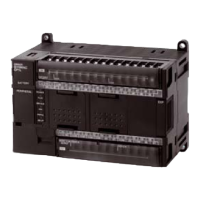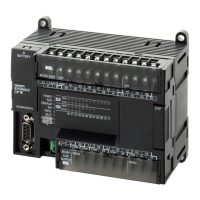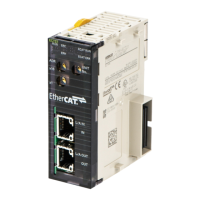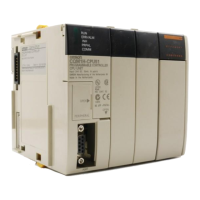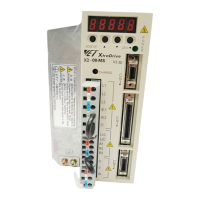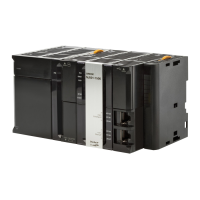437
Temperature Sensor Units Section 7-5
2. The following programming example shows how to convert the data for
temperature input 0 to BCD and store the result in D0 and D1. “0001” is
stored in D1 when the input data is a negative value. The following system
configuration is used.
Temperature unit setting 0 (°C)
Two-decimal-place Mode 0 (normal)
Input range setting 1 (Pt100: −200.0 to 650.0°C)
Input 0 CIO 2
2
#7FFF
1000.00
CMP(020)
(P_EQ)
1000.00
002
#7FFE
Always ON
P_On
CMP(020)
(P_EQ)
1000.01
3
#7FFE
Always ON
P_On
CMP(020)
Detects completion of input 1 initialization.
(P_EQ)
1000.02
2
#1388
CMP(020)
(P_GT)
1000.03
(P_LT)
2
D0
BCD(024)
3
#7FFF
1000.01
CMP(020)
(P_EQ)
1000.02
3
#1388
CMP(020)
(P_GT)
1000.03
(P_LT)
3
D1
BCD(024)
Detects completion of input 0 initialization.
ON when input 0 has been initialized
ON when input 1 has been initialized
Execution condition
Detects an open-circuit alarm or Unit
error by checking converted temperature
data for the error code 7FFF.
ON when an open-circuit alarm or Unit
error has been detected for input 0.
Checks to see if the temperature data
in word 2 has exceeded 500.0°C (1388
hex without decimal point).
ON for an input 0 temperature error
Converts the temperature data for
input 0 to BCD and stores the result in
D0.
Execution condition
Detects an open-circuit alarm or Unit
error by checking whether the error
code 7FFF has been output
ON when an open-circuit alarm or Unit
error has been detected for input 1.
Checks to see if the temperature data
in word 3 has exceeded 500.0°C
(1388 hex without decimal point).
ON for an input 1 temperature error
Converts the temperature data for
input 1 to BCD and stores the result in
D1.
CP1H
CP1W-TS001/101
CPM1A-TS001/101
Temperature Sensor Unit
Inputs
Outputs
CIO 0
CIO 1
CIO 100
CIO 101
CIO 2
CIO 3
None
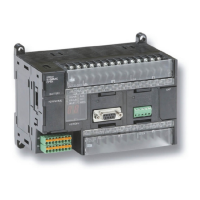
